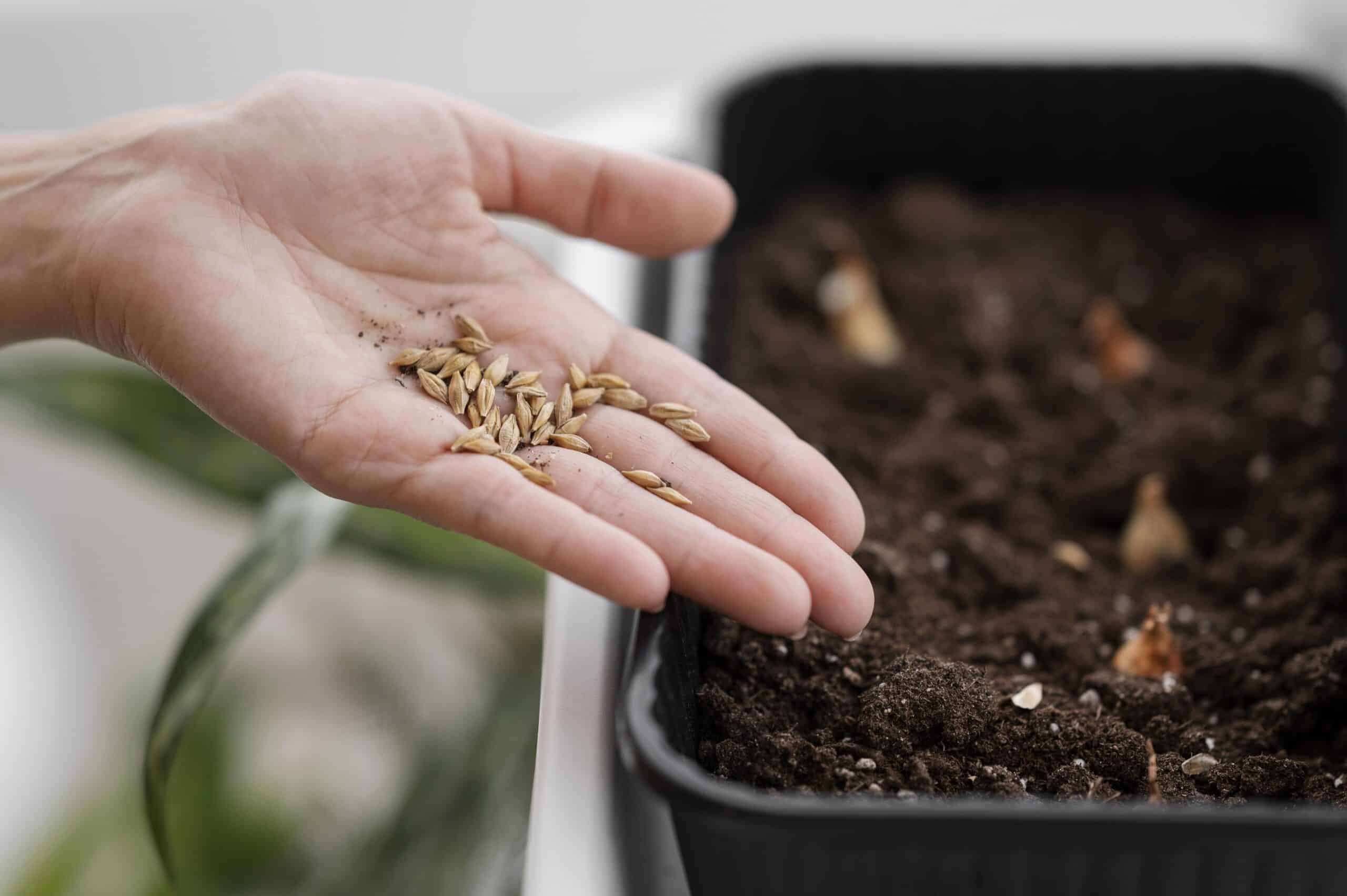Key Takeaways
- Choose a well-drained, partially shaded location for planting monkshood to ensure optimal growth and flowering.
- Prepare the soil by adding organic matter such as compost and ensuring a slightly acidic to neutral pH level to create ideal conditions for aconitum plants.
- When planting monkshood in gardens, ensure that the crown of the plant is at soil level and water thoroughly to establish strong roots.
- Regular watering, especially during dry periods, is crucial for the health and vitality of monkshood plants.
- Fertilize aconitum in early spring with a balanced fertilizer and prune after flowering to maintain a tidy and healthy growth habit.
- Propagate perennial monkshood through division in spring or by seed and provide adequate winter protection to ensure the plants’ survival.
- It’s time to learn, how to grow aconite!
Overview of Monkshood Plants
Planting Aconite
 Aconite, also known as monkshood or wolfsbane, is a stunning perennial plant that can be grown in your garden. When planting aconite, ensure the soil is well-drained and rich in organic matter. Choose a location with partial shade to protect the delicate flowers from direct sunlight.
Start by digging a hole twice as wide and deep as the plant’s root ball. Place the aconite in the hole, backfill with soil, and water thoroughly. Mulch around the base of the plant to retain moisture and suppress weeds.
Aconite, also known as monkshood or wolfsbane, is a stunning perennial plant that can be grown in your garden. When planting aconite, ensure the soil is well-drained and rich in organic matter. Choose a location with partial shade to protect the delicate flowers from direct sunlight.
Start by digging a hole twice as wide and deep as the plant’s root ball. Place the aconite in the hole, backfill with soil, and water thoroughly. Mulch around the base of the plant to retain moisture and suppress weeds.
Caring for Aconite
To care for aconite, keep the soil consistently moist but not waterlogged. Water deeply during dry spells and fertilize in early spring with a balanced fertilizer to encourage healthy growth. Deadhead faded flowers regularly to promote continuous blooming throughout summer. In late fall, cut back spent foliage to ground level when it turns brown after frost. This helps protect against diseases and pests while maintaining an attractive appearance during winter.Selecting Suitable Locations for Aconitum Planting
Partial Shade
 When planting aconite, it is crucial to choose a location that offers partial shade. This will protect the plant from intense sunlight, which can be harmful. Direct sunlight can scorch the delicate leaves and flowers of the aconite plant.
A suitable spot with partial shade might be under a tree canopy or near taller plants that can provide some protection from direct sun exposure. By selecting an area with partial shade, you ensure that your aconite plant thrives in an environment that suits its needs.
When planting aconite, it is crucial to choose a location that offers partial shade. This will protect the plant from intense sunlight, which can be harmful. Direct sunlight can scorch the delicate leaves and flowers of the aconite plant.
A suitable spot with partial shade might be under a tree canopy or near taller plants that can provide some protection from direct sun exposure. By selecting an area with partial shade, you ensure that your aconite plant thrives in an environment that suits its needs.
Well-Draining Soil
In addition to partial shade, another essential consideration when choosing a location for planting aconitum is ensuring that the area has well-draining soil. Waterlogged soil around the roots can lead to root rot and other issues. Choose areas where water drains easily after rainfall or watering to prevent waterlogging. Sandy loam or loamy soils are often ideal, providing good drainage for the aconite plant’s roots.Protection from Strong Winds
Lastly, when considering locations for growing aconites, it’s beneficial to consider positioning them near taller plants or structures to offer protection from strong winds. A windy environment can damage the delicate stems and flowers of these plants.Soil Conditions and Preparation for Monkshood
Ideal Soil Conditions
Aconitum, known as monkshood, thrives in moist soil with a slightly acidic to neutral pH level. This means that the soil should not be too alkaline or too acidic. The ideal pH range for growing aconite is between 6.5 and 7.5. Properly preparing the soil is important to ensure the best growth for your monkshood plant. Incorporating organic matter such as compost or peat moss into the soil can help improve its texture and fertility, providing essential nutrients for the plant’s growth.Testing and Amending the Soil
Before planting aconite, it’s crucial to test the soil to ensure good drainage. Poorly drained soil can lead to root rot and other issues that may harm the plant. If necessary, amend the soil by adding materials like sand or perlite to improve its drainage capacity. Amending the soil will help create an environment where water flows through easily but retains enough moisture for proper growth without becoming waterlogged.Planting Techniques for Aconitum
Best Time to Plant
Plant monkshood in early spring or early fall when the weather is cooler. This timing allows the plant to establish its roots before facing extreme temperatures, giving your monkshood a better chance of thriving. When planting monkshood, it is crucial to dig a hole twice as wide and deep as the root ball. This ample space allows the roots to spread freely, promoting healthy development.Proper Planting Depth
To ensure your monkshood thrives, place the plant in the hole at the same depth it was previously growing. Placing it too shallow can expose its roots, while planting it too deep may suffocate them. The correct depth encourages strong growth and overall health for your monkshood.Essential Care and Watering Practices for Monkshood
Consistent Moisture
Aconite, also known as monkshood, thrives in consistently moist soil. It’s vital to ensure the soil remains damp but not waterlogged, particularly during dry periods. This can be achieved by watering the plant regularly, especially when there is insufficient rainfall. Consider mulching around the base of the plant to maintain consistent moisture levels and prevent evaporation. Mulch is a protective layer that retains soil moisture while suppressing weed growth. This helps create an optimal environment for aconite to flourish without competing with invasive weeds for nutrients and water.Watering Techniques
When watering aconite, it’s crucial to target the base of the plant rather than wetting its foliage. Directing water at the base ensures it reaches the roots where it’s needed most. This practice helps prevent fungal diseases when foliage remains damp for prolonged periods.Fertilizing and Pruning for Healthy Growth
Applying Balanced Fertilizer
Applying a balanced fertilizer in spring before new growth appears is crucial. This helps provide the necessary nutrients for healthy blooms. Gardeners can use a general-purpose fertilizer with an equal balance of nitrogen, phosphorus, and potassium. This promotes strong root development and vibrant flowers. A balanced fertilizer ensures the plant receives essential nutrients without promoting excessive leafy growth. It supports the overall health of the plant while encouraging robust bloom production. For instance, a 10-10-10 or 20-20-20 fertilizer nourishes aconite plants without causing nutrient imbalances.Deadheading Faded Flowers
Gardeners should deadhead faded flowers regularly to encourage prolonged blooming and prevent self-seeding. This simple practice maintains the garden’s aesthetic appeal and directs energy towards continuous flower production instead of seed formation. By removing spent blooms, gardeners can extend the flowering period of their monkshood plants throughout the growing season. Deadheading also prevents self-seeding, which can lead to unwanted proliferation in certain areas of the garden. By consistently removing faded flowers, gardeners can control where new seeds are dispersed and maintain a tidy appearance.Propagation and Overwintering of Monkshood
Propagation
Aconitum, known as monkshood, can be propagated through division in early spring or fall every few years. This process involves carefully digging up the plant and separating its roots into smaller sections to replant in different garden areas. By doing this, you can promote healthier growth and prevent overcrowding. Mulching around established plants in late fall protects them from extreme cold temperatures. This helps maintain a stable soil temperature and protects the roots from freezing. Providing additional mulch or cover for extra protection in regions with harsh winters is advisable.Overwintering
Overwintering perennial plants like aconitum involves taking special care during winter to ensure their survival and healthy regrowth in the following seasons. Mulching around these plants protects them from extreme cold and helps retain moisture, essential for their overall well-being.Dealing with Pests and Diseases in Aconitum Cultivation
Pest Management
Watch out for pests like slugs and snails, which may feed on young shoots and leaves. These critters can harm the growth of your aconite plants by nibbling on tender parts. To prevent this, you can set up physical barriers or use organic slug pellets to keep them at bay. Consider handpicking these pests during evening hours when they are most active.Disease Control
Monitor for signs of crown rot, powdery mildew, and common diseases affecting monkshood. If you notice any affected plant parts, promptly remove them to prevent the spread of the disease. Consider using fungicidal treatments if necessary to combat these issues effectively. Aconites are susceptible to certain diseases, like verticillium wilt, so it’s crucial to watch for symptoms such as wilting or yellowing leaves. Proper watering practices and well-drained soil can help mitigate the risk of this disease affecting your plants. Remember that good air circulation around the plants is essential in preventing fungal diseases from taking hold in your garden bed. When planting aconite, ensure proper spacing between plants to allow airflow and reduce humidity levels contributing to disease development.Final Remarks
You’ve now learned the ins and outs of growing aconite, from selecting the right location and preparing the soil to care for and propagating your monkshood plants. Remember, success in gardening often comes down to patience and consistency. So, keep an eye on those little guys, give them the TLC they need, and watch them flourish! Now it’s time to get your hands dirty and implement all these tips. Find the perfect spot in your garden and start your aconite cultivation journey. Happy planting!Frequently Asked Questions
How do I select the best location for planting Aconitum?
Choose a site with partial shade and well-drained soil to plant Aconitum. Avoid areas with strong winds or intense sunlight, which can damage the delicate flowers.What are the essential care and watering practices for Monkshood?
Keep the soil consistently moist but not waterlogged, especially during dry spells. Mulching around the plants helps retain moisture and suppress weeds, promoting healthy growth.Are There Any Potential Risks or Benefits of Growing Aconite for Personal Use?
Aconite, also known as wolf’s bane, has a long history of medicinal use in traditional Chinese and Ayurvedic medicine. However, it is important to note that aconite uses and benefits are also accompanied by potential risks, as it is highly toxic when not prepared and used correctly.

